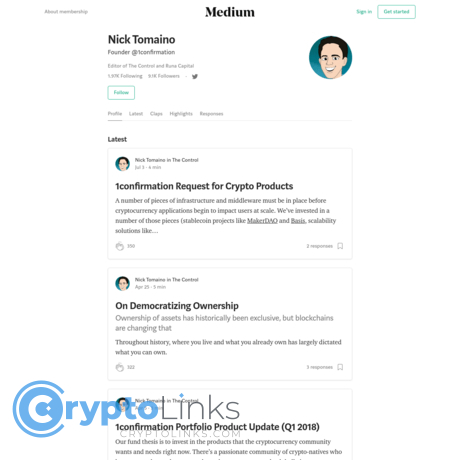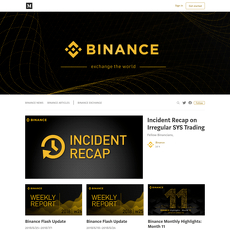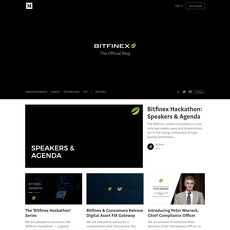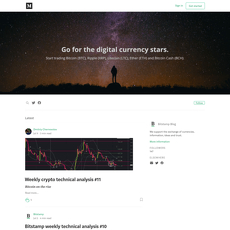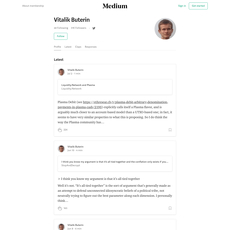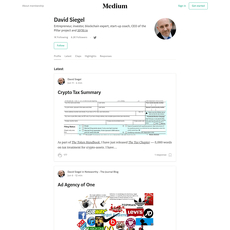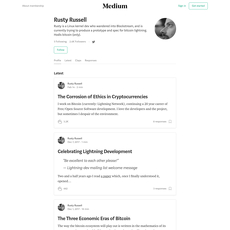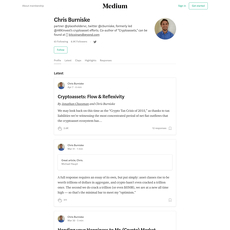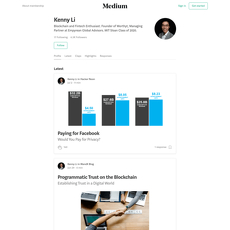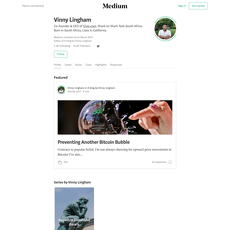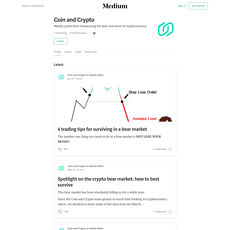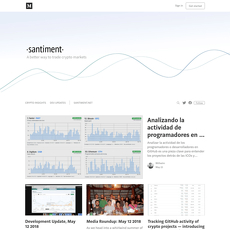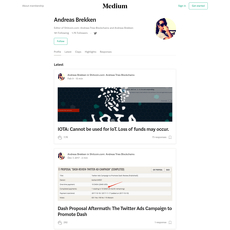Nick Tomaino Review
Nick Tomaino
medium.com
Nick Tomaino (@ntmoney) Medium Review Guide: Everything You Need to Know + FAQ
Ever see smart people name-drop Nick Tomaino’s Medium and think: “Should I be reading this too?”
If that’s you, you’re in the right spot. I’ll show you exactly how I read Nick’s posts, what to expect, and how to turn his ideas into practical crypto research you can actually use. No fluff, no endless tabs—just a clear path to signal.
Simple rule: read for frameworks, not hot takes.
Describe problems or pain
Crypto is noisy. Even good writing gets lost in hype, long think pieces, and takes that don’t help you make better decisions. When it comes to Nick’s Medium, this is what I hear most from readers:
- “I can’t tell what’s actionable.” Great narratives—no clear next steps for builders or investors.
- “I don’t know where to start.” Do you begin with token design, founder traits, or market structure?
- “Is there bias?” He’s a fund manager—how do I account for that and still learn?
- “It takes too long to extract value.” You skim, nod, close the tab, and forget it all next week.
These aren’t minor issues. They affect outcomes. A few quick realities:
- Online reading isn’t built for depth. Research from Nielsen Norman Group shows most people scan in an F-pattern and miss key details. That’s a problem when a single sentence contains the real insight.
- Ideas fade fast. The Ebbinghaus forgetting curve shows we forget most new info within days without review. If you don’t capture and revisit frameworks, you’ll remember vibes, not principles.
- Quotes ≠ decisions. It’s easy to collect spicy lines. It’s harder to translate them into a repeatable checklist you can run on any project.
Example of what usually happens: you read an essay praising “user-owned networks,” get excited, but don’t translate it into questions like, What does user ownership look like here? Who accrues value? What’s the path from speculation to utility? Without that bridge, the insight never reaches your workflow.
Promise solution
Here’s how I make Nick’s writing work for me:
- Context first: understand the lens he writes from (top crypto investor, long-term, builder-first).
- Read strategically: start with foundational essays, then move to themes like user ownership, market structure, and founder qualities.
- Extract frameworks: turn each post into a set of questions you can reuse across tokens, products, and teams.
- Assume bias smartly: note possible fund exposure and still harvest the principles.
- Build a simple system: quick notes, tags, and reminders so you keep the signal and ditch the noise.
You’ll get a clear map of what he writes, how often he posts, what’s worth your time, and a practical way to apply it—without reading everything.
Who this guide is for and what you’ll gain
- Builders: turn essays into hiring traits, token design questions, and go-to-market checklists.
- Early-stage investors: stress-test theses with reusable lenses for moats, distribution, and timing.
- Serious learners: follow a clean path through his archive so you understand crypto’s long arcs, not just the latest cycle.
By the end, you’ll know how to read Nick’s Medium the way pros read research: fast, focused, and repeatable. Ready to make that first pass count? Up next, I’ll answer the question most people ask before anything else: who is Nick Tomaino and why does his Medium actually matter?
Who is Nick Tomaino and why his Medium matters
If you’ve ever felt the crypto feed is 95% noise and 5% signal, you’re not imagining it. An MIT study showed false news spreads faster than the truth on social platforms, which is exactly why I pay attention to thinkers who play the long game. Nick Tomaino is one of them. His Medium (https://medium.com/@ntmoney) matters because he doesn’t write to chase a spike in claps—he writes to sharpen how founders and investors think about user-owned networks, incentives, and durable advantages.
“In a market obsessed with speed, the edge often comes from patience, clarity, and skin in the game.”
That’s the energy behind Nick’s essays: fewer hot takes, more frameworks you can pick up, test in the wild, and reuse.
Quick background and credibility
Nick is the founder and general partner at 1confirmation, a crypto-focused venture fund launched in 2017. He’s been early to several defining moments in the space and built a reputation for backing real networks, not just flash-in-the-pan tokens. Before that, he was part of the early team at Coinbase, which gave him a front-row seat to user adoption, regulatory reality, and the mechanics of bringing crypto to a mainstream audience.
Why that matters for his writing:
- Operator’s lens: He’s seen what actually gets built and used, not just what looks good in a deck.
- Early-stage pattern recognition: His fund lives at the idea-to-product edge, which is where mental models are forged and tested fast.
- Skin in the game: When a writer is also a long-term investor, you tend to get fewer narratives and more durable theses.
Look at where his interests have landed in the real world—think early bets on user-owned marketplaces and crypto-native creator platforms. That alignment between what he writes and what he funds is exactly the kind of “practice what you preach” I want in my reading stack.
What he tends to write about
Nick’s Medium is less about headline-chasing and more about clear, reusable thinking. Typical themes you’ll run into:
- User ownership as an engine: How tokens and aligned incentives turn users into evangelists, contributors, and governors.
- Founder quality and market timing: What separates missionaries from mercenaries, especially in sideways markets.
- Crypto networks over companies: Why protocols and marketplaces with strong community moats compound faster than “web2.5” wrappers.
- Token design and distribution: Practical lenses for fair launches, supply schedules, and avoiding extraction that kills long-term value.
- Market structure and cycles: How to keep working frameworks steady while narratives rotate.
- Real usage, not vanity metrics: The difference between speculative volume and products people come back to.
Expect a consistent thread: ownership and incentive design as the core product, not just a growth hack. That’s especially useful in a world where quick-hitting token campaigns can create a mirage of traction. He repeatedly points readers back to questions like “who captures value here?” and “how resilient is this community when rewards shrink?”
There’s a reason this style stands out. Long-form, framework-first reading reduces the whiplash that comes from feed-scrolling. When you anchor research to first principles, you make fewer emotionally-driven decisions and you’re quicker to spot fragile narratives. If you’ve ever regretted a click-fueled trade, you know exactly why this matters.
Who gets the most value from his posts
His essays aren’t for everyone—and that’s a good thing. They’re best for people who want to build or invest with a compass, not a weathervane.
- Founders: You’ll get practical ways to think about token distribution, community incentives, and what “moat” means in crypto (hint: it’s often social, not just technical). Use his mental models to stress-test your launch plan and avoid short-term optimization that poisons long-term trust.
- Early-stage investors: If you scout pre-product or pre-token, his focus on user ownership, market structure, and founder traits is gold. It helps you filter pitches, ask sharper questions, and separate real network effects from paid attention.
- Serious learners: If you’re past the “number go up” phase and want to understand why some systems compound, you’ll appreciate how he frames trade-offs. You’ll walk away with fewer opinions and more testable hypotheses.
Here’s the emotional truth I keep coming back to: it’s scary to slow down when everyone else is screaming “now.” But slowing down on the right ideas is how you actually speed up your outcomes. That’s the value of a clean, bias-aware, long-term lens—and why I keep Nick’s Medium on my short list.
If you’re ready to make your time count, what’s the fastest way to navigate his archive and start strong? I’ll show you exactly how I map his layout, cadence, and best starting points next—so you can skip the rabbit holes and get straight to the signal.
A smart tour of @ntmoney on Medium
Open Nick Tomaino’s Medium (@ntmoney) and you’ll notice two things fast: it’s clean and it’s intentional. No wallpaper of hot takes. Fewer posts, more signal. That’s exactly why it’s easy to get value if you know how to scan, sort, and read with purpose.
“Writing is thinking. To write well is to think clearly.”
That’s the energy here. So let me show you how I move through his archive—quickly—without missing the pieces that sharpen your crypto judgment.
Posting cadence and format to expect
Don’t expect a weekly grind. Expect substance when it matters.
- Cadence: Sporadic, clustered around inflection points in crypto. Some quarters are quiet, then a burst of essays when a new primitive, consumer moment, or market shift is worth talking about.
- Length: Mostly short-to-mid essays (think 3–10 minute reads). Enough depth to carry a framework, light enough to finish over coffee.
- Style: Plain language, no theater. Claims, context, and a mental model you can reuse. Minimal charts, maximal clarity.
- Format mix: Standalone theses, founder/market notes, and occasional reflections tied to portfolio learnings and multi-cycle patterns.
Pro tip: use Medium’s “reading time” to sequence a quick session. I’ll queue one long read and two short reads so I always leave with at least one reusable idea.
Recurring themes and frameworks
Patterns repeat. That’s helpful. Here are the lenses I see again and again in Nick’s posts—and how I translate them when I’m evaluating a protocol or token:
- User ownership as product-market advantage: Tokens aren’t confetti; they’re incentives. Look for alignment between contributor value and token accrual, not just airdrop buzz. I’ll map who does the hard work and who captures upside.
- Community as the moat: He returns to community quality over vanity metrics. Signals: repeat contributors, third-party tooling, meaningful governance participation, and culture that attracts talent.
- Founder quality and taste: Builders who handle permissionless chaos with clear priorities. Translation: fast iteration, crisp storytelling, high signal-to-noise decisions, and an instinct for where crypto actually helps users.
- Token design and distribution: Scarcity theater is useless; distribution that seeds real usage is everything. I’ll check utility, unlock schedules, contributor allocations, and whether liquidity deepens the network rather than just the chart.
- Market structure and timing: Incentive cycles drive behavior. He pays attention to catalysts (cost to use, developer tooling maturity, infra reliability) instead of just prices. I note “when this becomes cheap, it becomes mainstream” moments.
- Composability and leverage points: What new primitives a protocol unlocks, and who builds on top. If I can’t identify second-order builders, I tag it as fragile.
These aren’t just opinions; they’re checkable. If a project wins users without deep community involvement or clear token utility, the gap shows up in retention and developer energy.
Best way to start reading
If you’re new to his Medium, don’t scroll randomly. I use this simple order of operations to save time and keep context:
- Step 1 — Foundation first: Start with essays that lay out why user-owned networks matter and how tokens align contributors. These set the mental model. You’ll recognize them by clear definitions and timeless reasoning.
- Step 2 — Topical essays: Move to pieces tied to parts of the stack you care about (consumer apps, infra, DeFi, NFTs). Skim for the claim, the evidence, and the implied “if this, then that.”
- Step 3 — Contrarian or cycle takes: Read the ones that push against consensus. Whether you agree or not, extract the falsifiable statements—what would make this right or wrong within 6–12 months?
- Step 4 — Create a mini-map: On a notepad, write one sentence per essay: “This claims X will win because Y signal will appear in Z metric.” That map becomes gold when you revisit in a quarter.
Backed by research: active reading beats passive skimming. Studies like Mueller & Oppenheimer (2014) found that taking concise, conceptual notes improves understanding and recall versus verbatim copying. In practice, one sentence of your own beats five sentences of quotes.
Signs you’re reading it right
Here’s the self-check I run while reading @ntmoney. If these are true, I know I’ve extracted insight—not just vibes:
- You can restate the thesis in one line without the essay open.
- You can point to one metric that would confirm or falsify the claim (e.g., weekly active creators, developer integrations, L2 transaction costs, governance quorum).
- You wrote a micro-checklist you can apply to a project you already follow.
- You spotted an assumption (about distribution, user behavior, regulation, or infra readiness) and wrote the opposite case in one bullet.
- You set a revisit date in 60–90 days to compare reality with the thesis. This taps the spacing effect—revisiting over time increases retention and accuracy.
Emotionally, it should feel like this: a little uncomfortable (because you’re testing your priors), a little excited (because you see a cleaner way to reason about a messy market), and noticeably calmer (because you’ve got a framework, not FOMO).
One more practical nudge: if you can’t find at least one “copy-paste” framework from a post—something you’d put into a deal memo or product spec—you’re probably reading too fast.
Want to turn those frameworks into a repeatable research system you can run every week, in under 30 minutes? That’s exactly what I’ll lay out next—ready to see the template I use and the tags that save me hours?
How to turn his ideas into your research workflow
Reading and nodding isn’t research. The goal is simple: extract the repeatable parts of @ntmoney’s thinking and run them on your own deals, tokens, and theses. Here’s the exact playbook I use so insights don’t evaporate the moment you close the tab.
“Read for frameworks, not headlines.” I keep this pinned in my notes. It saves me from novelty chasing and gets me back to decision-making.
Pull out frameworks, not just quotes
Quotes feel good; frameworks compound. When I read, I translate each strong claim into a reusable decision rule or mental model. Try this four-step pass on any essay:
- Claim → Principle → Test. If he claims early user-ownership accelerates adoption, the principle is “incentives drive distribution.” The test is “Does this protocol give ownership to the highest-intent users early enough to matter?”
- If/Then rules. If ownership is earned (usage-based) rather than sprayed (airdrop-farming), then retention and governance participation should be higher in 3–6 months.
- Edge cases. Where would the principle break? Low-frequency apps, mercenary liquidity, or weak product-market fit.
- Metrics. What would prove or kill it? Gini of token distribution over time, cohort retention, proposal participation rate, fee payers vs. airdrop hunters.
Then I capture a one-card framework:
- Name: User-Ownership Flywheel
- Inputs: Earned distribution, aligned rewards, clear rights
- Signals: Retention by earning cohort, onchain participation, reduced sell pressure post-TGE
- Inverse: Spray-and-pray airdrops → short-term spikes, long-term decay
- Example use: Stress-test a new consumer protocol before joining a round
Do this for any theme you spot—founder qualities, token design, go-to-market. After 6–8 cards, you’ll notice you’re making faster, cleaner calls because you’re comparing models, not vibes.
Cross-check for bias and disclosures
Strong investors write from experience—and from a portfolio. That’s valuable, but you should label the angle while you learn from it.
- Scan for disclosures. Check the footer or intro of a post for positions or relationships. If none are listed, assume there could be exposure and proceed with a “bias tag.”
- Cross-reference holdings. Look at 1confirmation for portfolio signals. Example: if a post praises marketplace moats, remember 1confirmation has backed marketplace projects like OpenSea and SuperRare. That’s useful context, not a reason to dismiss the argument.
- Seek an independent counter-take. Pull one analyst thread or research note that disagrees and compare premises, not conclusions. Which metrics would settle the debate?
- Run a pre‑mortem. “It’s 18 months later and the thesis failed—why?” This reduces optimism bias and surfaces hidden risks. Here’s a practical guide: HBR: Performing a Project Premortem.
- Remember: disclosure isn’t a cure-all. The literature shows disclosure can create overconfidence or pressure to comply (Cain, Loewenstein, Moore). Treat disclosure as a data point, not a free pass.
Bias checklist I apply in 60 seconds:
- Possible fund exposure? Yes/No/Unknown (with one-line rationale)
- One independent opposing source reviewed? Yes/No
- Pre‑mortem written? Yes/No
- Metrics that would falsify the idea listed? Yes/No
Build a repeatable note-taking system
Your memory is a leaky bucket. A simple template beats a thousand highlights.
- Tool: Notion, Obsidian, or a plain text doc—doesn’t matter. Consistency does.
- Template fields I use:
- Source: @ntmoney on Medium | URL: … | Date: …
- 3-sentence summary: What’s the core claim?
- Frameworks: Name them; 1–3 bullet rules
- Metrics to watch: Concrete, queryable
- Bias tag: Exposure risk and why
- Open questions: What would I need to believe?
- Next action: One small test I can run this week
- Tags: infrastructure, consumer, DeFi, NFTs, governance, tokenomics
Example note snippet:
Frameworks: “Earned > sprayed” token distribution; “Community power-law” contributors; “Founder obsession with user experience” as moat.
Metrics: Cohort retention of earners; proposal turnout; fee payers trend.
Next action: Pull last 90 days governance data for Project X; compare participation between airdrop farmers vs. active users.
Focus on generative notes (restate in your words, extract decisions). Research on learning shows this style leads to deeper understanding than transcription (Mueller & Oppenheimer, 2014). Schedule quick reviews at 24 hours and one week—spaced repetition improves retention and application (Cepeda et al., 2006).
From reading to action
Turn one essay into one checklist you can run on a startup, token, or thesis within an hour. I use this 30–60 minute loop:
- Convert ideas → checklist. Pull 8–12 yes/no or 1–5 questions anchored to the frameworks you captured.
- Pick a target. A project you’re considering for a call, a token on your watchlist, or a thesis you want to pressure-test.
- Score and decide. Tally results; greenlight next research step, or archive with notes.
Ready-to-use checklist (edit to taste):
- Clear user-ownership mechanism with earned distribution?
- Ownership confers real rights (fees, governance, access), not just a sticker?
- Founder-market fit evident in shipped product and community pull?
- Network effects identifiable and measurable within 6–12 months?
- Token design aligned to usage (not just fundraising)?
- Early distribution targets the highest-intent users, not mercenary capital?
- Defensibility beyond token incentives (UX, data moats, integrations)?
- Onchain metrics available to verify claims (and I know which dashboards)?
- Major risks named with a falsification metric and timeline?
- Bias tag applied (portfolio overlap, friendships, narrative incentives)?
Mini example (fictional): L2 payments protocol “ZapPay.”
- Ownership: Earned via payment routing volume and dispute resolution. Good.
- Rights: Fee share to validators and active routers; governance is binding. Good.
- Distribution: 70% to users over 4 years; early epoch caps farmable wallets. Good with caveats.
- Defensibility: SDK integrated into 4 wallets; offramps in 3 regions. Medium.
- Risk metric: If active routers churn >25% after TGE, reassess thesis.
- Bias tag: Unknown exposure; check 1confirmation portfolio and founder networks.
Next actions in 20 minutes:
- Spin up a watch doc with three dashboards: daily active payers, router retention, governance turnout.
- Book a 30-minute founder call focused only on distribution mechanics and early cohort health.
- Set a calendar tickler to re-score the checklist in 30 days.
Why the checklist? Because checklists cut cognitive load and reduce error—across high-stakes fields, they’ve been shown to improve outcomes by making decisions consistent and auditable (NEJM, 2009). Crypto isn’t surgery, but your capital deserves the same respect.
Here’s the kicker: not every thoughtful writer is worth your time. In the next part, I’ll show you the signals I watch—beyond claps and views—that predict whether someone’s ideas actually move the market. Curious which ones really matter?
What the signals say: quality, reach, and influence
Here’s how I separate real signal from noise when I read Nick Tomaino’s Medium and decide if it’s worth my time.
Engagement that actually matters
Claps and views are nice, but they’re weak predictors of influence. BuzzSumo’s large-scale study of 100M articles found a near-zero correlation between social shares and backlinks (authority citations). In crypto, the equivalent of “backlinks” is who reuses the ideas and builds on them.
- Founder references in the wild: The strongest tell is when early-stage founders reference one of his frameworks in a pitch, a product memo, or a post-mortem. I’ve heard “user ownership” and “earn the right to a token” pop up in decks and internal docs more than once. That’s real adoption of a mental model, not vanity engagement.
- Idea reuse across mediums: Watch for his concepts resurfacing in investor memos, podcast conversations, and conference panels—especially when the speaker doesn’t link back. If a framing quietly becomes shared language, it’s a sign the thinking stuck.
- Peer reactions vs. fan reactions: Quote-tweets from builders, protocol researchers, and other GPs matter more than retail applause. When operators at leading protocols debate or refine his points, that’s upstream influence.
- Longevity through cycles: If an essay from a past cycle gets resurfaced during a new narrative shift, it’s likely a genuine “evergreen” piece. Transient hot takes don’t get this treatment.
- Off-platform pull: Invitations to discuss the same thesis on respected podcasts or at technical meetups are higher-signal than a spike of Medium claps in week one.
Practical filter I use:
- Did any founder I respect implement this lens in a tangible decision?
- Do I hear the idea in rooms where money and code meet (investment committees, core dev calls), not just on social?
- Does the thesis survive when I stress-test it with on-chain data and cohort retention?
“Attention is cheap; adoption is expensive. Judge ideas by who builds with them, not who claps for them.”
How it stacks up to other investor blogs
I read Nick alongside firm blogs and big newsletters because each plays a different role.
- Versus firm blogs (a16z, Paradigm, USV): Those posts can be deeply researched with helpful charts and references, but they’re often committee-edited and aligned to a platform strategy. Nick’s edge is personal clarity and compression—fewer words, stronger priors, and frameworks you can actually apply next week.
- Versus hype-driven newsletters: Newsletters that chase weekly narratives are great for awareness but weak for decision-making. Nick tends to focus on durable principles (ownership, distribution, founder-market fit in crypto). That makes his archive more useful when you’re heads-down evaluating a token or product.
- Where he’s strongest: Early consumer crypto and network effects. His fund’s early bet on OpenSea lines up with a long-running interest in user-owned markets and creator economies. Whether or not you agree with every conclusion, that consistency helps you understand how he’ll see the next wave.
- Where to complement him: If you’re researching L1/L2 performance, MEV, or protocol-level cryptography, pair his essays with research notes from technical teams and the Electric Capital Developer Report to cover the lower-level details.
Short version: firm blogs give you breadth and polish; he gives you a sharp, founder-first lens that travels well across cycles.
Red flags to keep in mind
Strong thinkers have strong biases. The goal isn’t to avoid them—it’s to recognize and adjust.
- Echo chambers:Crypto Twitter can turn any good idea into a slogan. If a post is getting unanimous praise inside a niche, go find the smartest counterargument outside that niche before you act.
- Narrative drift: Big wins can bend a lens. Success around NFTs and creator economies might overweight consumer use cases. Sanity check by asking: does this thesis hold for DeFi primitives, infra, or dev tooling with very different user journeys?
- Overfitting past cycles: What worked in 2019–2021 may not work in 2025’s liquidity, gas, and distribution landscape. Use base rates and falsifiable checkpoints: retention cohorts, CAC-to-liquidity ratios, and real user funnels instead of headline volume.
- Incentive bias: Assume there’s potential exposure via 1confirmation. That doesn’t invalidate the argument, but it changes how hard you should push on downside scenarios.
- Story > stats risk: A clean narrative can mask weak data. Cross-check with:
- On-chain MAUs, fee/user, and 30/60/90-day retention
- Token supply distribution and unlock schedule (Gini, top holder share)
- Developer momentum (monthly active devs, repos, commits; Electric Capital trends)
- Governance participation and treasury runway
- Wash trading flags for NFT/DEX volumes
A quick way to keep yourself honest: apply Philip Tetlock’s superforecasting habit—translate claims into probabilities and timelines. If a thesis can’t be expressed as “70% by Q4 when X leading indicator crosses Y,” it’s probably not investment-grade yet.
Curious about the basics people always search—who Nick is, how often he posts on Medium, and whether he discloses positions? I’ve got fast, straight answers next, so you can read with context and save time. Ready for the quick hits?
People also ask: quick answers
Who is Nick Tomaino?
He’s the founder and general partner at 1confirmation, an early-stage crypto fund. Before that, he worked at Coinbase in the early days, which gives him a rare operator–investor perspective. On Medium, he writes under @ntmoney, focusing on why crypto networks matter, what great founders do differently, and how user ownership changes products.
I like his work because it’s not trend-chasing. It’s builder-first and grounded in long-term incentives.
“Read thinkers for their frameworks, not their hot takes.”
Is Nick Tomaino legit and experienced?
Short answer: yes. His fund has backed meaningful projects over multiple cycles, including names you’ll recognize. Check the 1confirmation portfolio to see examples like OpenSea, dYdX, and SuperRare. I constantly see founders cite his essays in pitch decks and hiring docs—always a strong external signal.
- Years in the trenches: early Coinbase team + 1confirmation since 2017.
- Clear thesis: user ownership, crypto-native networks, and founder quality as core edges.
How often does he post on Medium?
Infrequently but meaningfully. Expect a handful of essays per year—often around inflection points when the post actually moves the conversation. I treat each one like a research memo rather than a blog update.
- Don’t refresh daily: use the RSS feed here.
- Set alerts on X: turn on notifications at @ntmoney so you catch new posts the hour they drop.
What is 1confirmation and what do they focus on?
It’s a crypto-native venture fund that backs founders very early (pre-seed/seed) and holds patient, concentrated positions. In plain English: they pick a few things they believe in and stay useful to those teams for years.
- Focus areas: consumer crypto, NFTs/creator economy, DeFi, and core infrastructure.
- How that shapes his writing: founder-centric, long horizons, and a strong bias toward real user ownership vs. financial gimmicks.
Does he disclose investments or conflicts?
Generally, yes—when he writes about a portfolio company, you’ll often see a note. That said, I assume default bias: he’s long crypto and long his founders.
- My simple rule: if he’s praising a project, quickly check the 1confirmation portfolio. If it’s there, read the post as an informed investor’s memo—not a neutral review—and still extract the frameworks.
What topics does he cover most?
He keeps coming back to themes that outlast “cycle chatter.” Expect:
- User ownership: why tokens can turn users into owners (and when they shouldn’t).
- Token design: distribution, utility, and how incentives create or destroy moats.
- Founder qualities: what separates resilient crypto teams from narrative-chasers.
- Market structure: where the puck is going in infra, consumer, and DeFi.
- Community and governance: what “skin in the game” looks like beyond slogans.
Where else can I follow him?
- Medium: @ntmoney for long-form essays.
- X (Twitter): @ntmoney for commentary and links to new posts.
- Fund updates: 1confirmation.com and the portfolio page for signal on what he’s backing.
- Podcasts/interviews: search “Nick Tomaino 1confirmation” on YouTube or Spotify—great context when you want voice and nuance.
Want the exact essays I’d start with and how to read them in under an hour—plus the one piece that changed how I judge token distributions? Keep going.
Popular starting points and how to read them
If you’ve got just one hour to sample Nick Tomaino’s (@ntmoney) Medium, here’s exactly how I’d spend it and the lens I’d use while reading. The goal isn’t to agree or disagree—it’s to leave with repeatable frameworks you can apply to your own projects, investments, and research.
“Read for frameworks, not forecasts; frameworks age well, forecasts don’t.”
Foundational essays
Start with the “evergreen” pieces—the ones where Nick explains why user ownership matters, how tokens create new types of moats, what makes crypto-native products feel different, and how communities become distribution.
- What to look for: clear definitions, cause-and-effect, and tests you can reuse. For example, when he talks about user ownership, highlight the link between distribution and retention: users who own a piece of the network stick around longer and evangelize harder.
- A practical lens: take his point about tokens as distribution and ask:
- Does this protocol turn users into owners in a way that’s actually earned (contribution-based) vs. airdrop theater?
- Is the token genuinely useful (fees, governance with teeth, collateral, access), or just a reward wrapper?
- Could the same behavior be incentivized cheaper with points or equity? If yes, the token probably isn’t essential.
- Why it resonates: This line of thought showed up early in his writing on NFTs and creator economies, long before 2021 mania. That thesis mapped to real outcomes—OpenSea (an early 1confirmation bet) became the category leader as creators and collectors coordinated around ownership. Independent datasets like Chainalysis have since reported billions in NFT trading volume during the 2021–2022 cycle, validating the basic “user-owned media” arc.
Time box: 15 minutes. Read one foundational piece, then write a 3-line summary and a 5-bullet checklist you’ll reuse later.
Market-structure or narrative pieces
Next, pick one of his posts that talks cycles, narratives, or where value accrues (L1 vs. L2 vs. apps, infra vs. consumer). The mistake readers make is treating these as trade signals. I treat them as base-rate builders.
- How to extract signal:
- Identify the unit of progress he cares about (active wallets, fee payers, onchain revenue, developer traction) and track that over price. Tools like L2BEAT and public Dune dashboards help you fact-check the shape of a narrative in minutes.
- Underline any explicit “what would change my mind” statement. If it’s missing, write your own. This protects you from narrative inertia.
- Separate structural from cyclical: structural is distribution shifts (e.g., mobile wallets improving conversion, L2 fees collapsing and unlocking new use cases), cyclical is momentum and headlines.
- A quick checklist I use on his market takes:
- New distribution unlocked? (e.g., wallets, L2s, embedded fiat ramps)
- Real payer on the other side? (consumers, creators, DAOs, devs)
- Does the design reduce friction by 10x, or just subsidize it?
- If token is central: where do cash flows or control actually settle?
- Why this matters: Studies in decision science show that adopting “base-rate” thinking reduces overconfidence in noisy domains. Treat his narratives as base rates you revisit, not instant trades.
Time box: 20 minutes. One careful read, then 5 minutes to log the metric you’ll track monthly.
Builder-focused posts
My favorite set: posts where he outlines what great crypto founders do differently—how they recruit, ship, earn community trust, and design tokens that make sense.
- Turn it into a hiring/investing checklist:
- Founder-market obsession: Can the founder explain the user in one sentence and show receipts from talking to them weekly?
- Crypto-native product taste: Does the product give users an instant onchain “aha” (ownership, portability, composability), or could it be Web2 with a token glued on?
- Distribution realism: Who brings the first 1,000 true fans? What channels—Discords, creators, client SDKs, wallet partnerships—will compound?
- Token restraint: Can they explain the minimum viable token? Do they defer emission until product pull is real?
- Governance with teeth: If governance is in scope, what decisions will token holders actually make, and how are decisions enforced?
- How to use it on Monday: If you’re a founder, run your next sprint plan through the list. If you’re an investor, score calls 1–5 on each dimension and track your hit rate. This creates the feedback loop most people never build.
- Real-world anchor: The teams that won in NFTs and DeFi didn’t just “launch a token”—they shipped relentlessly, kept emission dry powder for product-market fit, and built distribution moats via creators, liquidity partners, or developer ecosystems. That pattern shows up again and again in Nick’s writing.
Time box: 15 minutes. Read one builder-focused post, then translate it into a one-page checklist for your team.
What to skip (for now)
If you’re new and short on time, here’s what I’d park for a second pass:
- Announcement-style posts tied to specific launches, conferences, or short-lived market events. They’re useful context, not compounding insight.
- Deep portfolio updates unless you’re researching that exact sector. Save them to a tag in your notes and circle back when relevant.
- Thread-like short posts that compress ideas you’ll find richer in the longer essays. Start with depth; you can skim summaries later.
Your 60-minute stack:
- 15 min: one foundational essay → 5-bullet framework
- 20 min: one market-structure piece → pick a metric to track
- 15 min: one builder-focused post → turn into a checklist
- 10 min: notes and a calendar reminder to revisit in 30 days
Want the exact way I follow, filter, and never miss the signal without drowning in feeds? I’ll show you the simple setup I use next—would a two-minute routine that surfaces only the posts you care about be helpful?
Follow, filter, and stay updated without overwhelm
You don’t need 20 tabs open to keep up with Nick. Here’s the simple setup I use to catch every new piece, file it by relevance, and pressure-test the ideas without drowning in takes.
Follow methods that actually work
I want signal, not noise. This is how I get it:
- Follow on Medium: Open medium.com/@ntmoney, hit Follow, and enable email notifications. Medium sometimes buries alerts, so I treat this as a backup, not the main feed.
- RSS (the most reliable): Add medium.com/feed/@ntmoney to your RSS reader (Feedly, Readwise Reader, or Inoreader). I forward this feed to a “Reading Queue” using Readwise, so highlights sync to my notes. It takes 2 minutes and never misses a post.
- X/Twitter alerts: Turn on notifications for @NTmoney and add him to a private “Crypto Thinkers” list along with @1confirmation. Lists cut through the For You fog, and you’ll often catch threads that expand on his essays.
- Email filter that actually surfaces: In Gmail, create a filter:
Has the words:(ntmoney OR "Nick Tomaino") AND medium
Apply labels: Nick/Queue, mark as Important, and Skip Inbox. This funnels everything to one place without pinging you at random times. - Weekly time block: I set a 20-minute Friday block called “Nick/Frameworks”. No meetings, no Slack. Read, pull one insight, tag it (see below), move on. Studies on time-blocking and focus show better recall and less context switching—this small habit compounds fast.
- Optional automation: Use Zapier or IFTTT:
- Trigger: New item in RSS feed
- Action: Create a page in Notion database or send a message to a Slack “reading-queue” channel
“What gets scheduled gets done.” A 20-minute block beats an endless backlog every time.
Create filters for relevance
Reading is easy. Finding the post you need at the exact moment you’re evaluating a token or founder is the real win. Here’s the tag system I use:
- Core tags (pick 1–2 max):
- Infrastructure (L1/L2, scalability, developer tools)
- Consumer (wallet UX, social, games)
- DeFi (AMMs, lending, MEV, market structure)
- NFTs (creator economy, ownership, culture)
- Governance (DAOs, tokenholder rights)
- Founders (team quality, values, execution)
- Token design (supply, utility, distribution)
- Stage: Idea, Thesis, or Post-mortem. This sets expectations for certainty.
- Use-now flag: Now (relevant to an active decision) or Later (for background).
- Bias check: Exposure? Yes/No/Unknown. If Yes, note the project and adjust weight—not to dismiss, but to frame.
- Takeaway in one line: Force yourself to write: “If this is true, I should change X.” The act of writing improves recall. Research on heavy multitaskers shows we’re bad at filtering without simple structures—this fixes that.
My Notion template for each post includes:
- Title + Link + Date
- Tags: Infrastructure | Token design | Thesis
- 1-sentence summary: “Strong distribution beats better tech if ownership is real.”
- Action: “Add ‘user ownership’ checklist to product diligence.”
- Follow-up: “Revisit after Q3 mainnet for on-chain retention data.”
Two examples of tagging in practice:
- Example A: An essay on user-owned networks with case studies
Tags: Consumer, Token design | Stage: Thesis | Use-now: Now
Why: You’re comparing two social protocols with different token unlocks next month. - Example B: A reflection on market structure in a new cycle
Tags: DeFi, Market structure | Stage: Idea | Use-now: Later
Why: Good context for timing, but not an immediate decision driver.
Share and stress-test
The best way to avoid echo chambers is to make disagreement easy and useful. Here’s how I run it with founders and teams:
- The 2–1–1 share (post to Slack/Discord or a founder chat):
- 2 sentences: your summary
- 1 question: “What must be true for this to hold?”
- 1 disconfirming check: “What evidence would make this wrong in 90 days?”
- Blind takes first: Ask everyone to post a 1–2 sentence take privately, then reveal. It prevents anchoring and groupthink.
- Assign a probability: “70% this framework applies to consumer wallets in 2025.” Add a calendar reminder to revisit in 3 months. That simple prediction habit keeps you honest.
- Red team rotation: Each week, one person argues the opposite case. You’ll catch missing assumptions fast.
- Keep a “What changed my mind” log: Any time a Nick essay shifts your view, write why. This creates a personal map of how your thinking evolves instead of collecting quotes you’ll never use.
“If we can’t state what would falsify a thesis, we don’t have a thesis.” Treat every post like a hypothesis, not a headline.
One last nudge: I set a recurring monthly “Review and prune” block to archive tags I no longer use. That small cleanup keeps the system fast. The Stanford research on multitasking and filtering backs this up—less clutter, clearer thinking.
Want to see how all this rolls up when deciding if his Medium is actually worth your time—and when it’s not? I’ll show you exactly where it shines next. Ready for the straight answer?
Is Nick Tomaino’s Medium worth your time? My take
Short answer: yes—if you want thinking that sharpens your judgment, not hot takes that expire in a week. His posts are rare but dense with experience. When I read his work, I’m not hunting for the next trade; I’m upgrading my mental models for founders, tokens, communities, and market structure. That pays dividends across cycles.
When it’s most valuable
It shines when you’re making decisions that require patience and clarity:
- Founders: Use his “user ownership” lens to stress-test growth tactics. For example, if you’re tempted to ship a points campaign, ask: what power do users actually gain, and how will that comp compound? I’ve seen teams switch from mercenary points to earned governance rights tied to real usage and contributor milestones, then track 30/60/90-day retention and governance participation as north stars instead of “XP totals.”
- Early-stage investors: Turn his founder and network notes into a quick pre-IC memo. One practical filter I’ve used: if a token claims “community ownership,” check whether the top-10 holders exceed 60% at TGE and whether emissions dump >30% in year one. I passed on a deal last quarter that failed both—strong narrative, weak ownership reality.
- Curious learners: Read an essay, then apply it to a live project. For instance, take his framing on community moats and run a simple comparison across two L2s: fees/users trend (Token Terminal), dev activity (Artemis/Sonar), and distribution fairness (Etherscan holders). You’ll feel the difference between a narrative and a durable advantage.
Keep your edge while you read
His writing is thoughtful—and he invests for a living. Respect both facts and keep your process tight:
- Assume incentives exist: If a post praises a category, check whether his fund has exposure. Don’t dismiss the insight—adjust for it.
- Build a 10-minute checklist from each essay:
- What’s the core claim?
- What would falsify it?
- Which 3 metrics would prove traction? (e.g., retention, fee growth, holder dispersion)
- What’s the base rate? (Comparable projects, cycle-adjusted)
- Quantify where you can: Pair ideas with data: Token Terminal for revenue/FDV, Dune for on-chain behavior, Etherscan/Nansen for holder distribution.
- Triangulate: Cross-read a skeptical take, then revisit your notes. “Adversarial collaboration” beats echo chambers.
- Keep a decision log: One paragraph, one timestamp, one expected outcome. Forecasting research shows that tracking your judgments improves accuracy significantly over time (Good Judgment Project), and checklists reduce complex errors across domains (WHO surgical checklist).
Simple beats clever: checklists and base rates cut noise and overconfidence—two killers of crypto decisions.
Bottom line
Nick Tomaino’s Medium makes you think straighter about crypto. Read it for frameworks you can reuse, not just takes to agree with. Note incentives, translate essays into checklists, and compare ideas across a few solid sources before you act.
I track and link to strong thinkers at cryptolinks.com/news, and his archive stays on that shortlist. If you approach it this way, you’ll get more signal, less noise, and much better crypto decisions.

